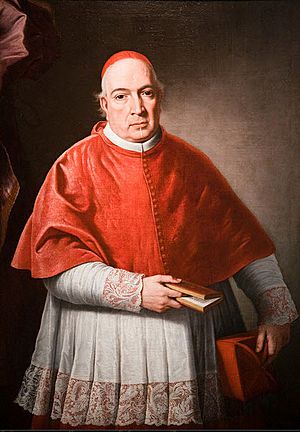Diego de Astorga y Céspedes facts for kids
Quick facts for kids His Eminence Diego de Astorga y Céspedes |
|
|---|---|
| Cardinal, Archbishop of Toledo Primate of Spain |
|

Portrait by Alonso Miguel de Tovar
|
|
| Church | Roman Catholic |
| Archdiocese | Toledo |
| See | Cathedral of Saint Mary of Toledo |
| Enthroned | 22 July 1720 |
| Reign ended | 9 February 1734 |
| Predecessor | Francisco Valero y Losa |
| Successor | Position vacant |
| Other posts | Bishop of Barcelona Vicar-General of Ceuta |
| Orders | |
| Ordination | 17 December 1689 |
| Consecration | 14 June 1716 by Luis Antonio Belluga y Moncada |
| Created Cardinal | 26 November 1727 |
| Personal details | |
| Born | 17 October 1663 Gibraltar, Kingdom of Spain |
| Died | 9 February 1734 (aged 70) Madrid, Kingdom of Spain |
| Nationality | Spanish |
| Alma mater | University of Granada |
Diego de Astorga y Céspedes (born October 17, 1663 – died February 9, 1734) was an important Spanish leader in the Catholic Church. He was a Cardinal, a Bishop in Barcelona, and an Archbishop in Toledo. He also held a powerful position called Grand Inquisitor.
Contents
Life and Church Career
Early Life and Education
Diego de Astorga y Céspedes was born in Gibraltar in 1663. Back then, Gibraltar was a Spanish town. He studied Canon law at the University of Granada. This is a special type of law used by the Church. He became a priest in 1689.
Becoming a Bishop
In 1705, Diego de Astorga y Céspedes became a high-ranking church official. He was named the Vicar-General of Ceuta. Later, in 1710, he became an Inquisitor in the region of Murcia.
In 1716, he was made the Bishop of Barcelona. This was a big deal because he was the first bishop there who wasn't from Catalonia. This change happened because of new rules from King Philip V of Spain. These rules were made after a big war called the War of the Spanish Succession.
Archbishop and Cardinal
Just four years later, in 1720, he became the Archbishop of Toledo. This meant he was the most important church leader in all of Spain, known as the Primate of Spain. He was also named Grand Inquisitor that same year, but he stepped down from that role quickly. A Grand Inquisitor was a very powerful judge in the Church.
In 1727, Pope Benedict XIII made him a Cardinal. Cardinals are very high-ranking officials in the Catholic Church. However, he never officially received the special red hat that cardinals wear. He also didn't take part in the election of the next Pope in 1730.
Diego de Astorga y Céspedes was also an advisor to King Philip V. He was part of the king's Privy council, which was a group of important people who helped the king make decisions.
El Transparente
Cardinal Astorga y Céspedes is famous for ordering a beautiful work of art. It's called El Transparente and it's in the Toledo Cathedral. He asked an artist named Narciso Tomé to create it.
El Transparente is a stunning example of Baroque art. It's a large, detailed sculpture and altar piece. It was placed behind the main altar in the cathedral. The Cardinal wanted this amazing monument to show the importance of the Holy Sacrament. It cost a lot of money, about 200,000 ducats. People loved it so much that they called it the 'Eighth Wonder of the World'!
Later Life and Legacy
Cardinal Astorga y Céspedes passed away in 1734 in Madrid. He is buried in the Toledo Cathedral, right at the feet of El Transparente.
Throughout his life, Bishop De Astorga y Céspedes strongly supported the devotion to Our Lady of Europe. This is a special way of honoring the Blessed Virgin Mary in Gibraltar, his hometown.
Images for kids
See also
 In Spanish: Diego de Astorga y Céspedes para niños
In Spanish: Diego de Astorga y Céspedes para niños


